How to Remove The Oxide Scale on The Surface of Stainless Steel Casting Billet?

The oxide film on the surface of the stainless steel casting billet is thin and dense, and it is not easy to fall off. Under normal conditions, the stainless steel casting billet will produce 0.2~0.3mm oxide scale in the heating furnace. The defects of the casting billet within this range can be removed with the oxide scale. Defects are not within this range. If the surface defects on the cast billet are not treated, they will inevitably be brought into the final product. Stainless steel casting billets generally cannot be used to clean the surface defects of the cast billet. Flame cleaning will cause the composition and crystal phase composition of the cleaned area of the cast billet to change, which affects the corrosion resistance of stainless steel products. Therefore, mechanical cleaning is a common and effective method for the surface treatment of stainless steel. The general methods include scale cleaning machine treatment, water explosion, and shot blasting machine cleaning.
Stainless Steel Chemical Composition
AISI 304; AISI 301; AISI 316;AISI 316L…
- Thickness: 0.02mm – 0.2mm
- Width: 25mm – 1600mm
1. Treatment of iron oxide scale cleaning machine
The scale cleaning machine is mainly composed of a steel brush roller, drive device, high-pressure water system, cooling water system, and clamping device. Two rollers with steel wires (called steel brush rolls) are installed on the roller table. The steel brush rolls rotate at a high speed in the opposite direction of the casting billet. The steel wire washes the cast billet surface to remove the oxidation attached to the cast billet surface. Iron sheet.
The scale cleaning machine is suitable for many kinds of steel, but the scale cleaning is not thorough enough.
Get it now:A Complete Guide to SUS Stainless Steel Banding
2. Water burst pool
The water explosion pool uses circulating water at room temperature as the cooling medium, puts the high-temperature cast slab into the pool, and uses “water explosion” to remove the oxide scale on the surface of the cast slab. The principle is that when water encounters a high-temperature cast slab, it instantly vaporizes, causing a “water explosion” and generating a large amount of high-pressure steam. The impact force of the steam acts on the surface of the cast slab to peel off the oxide scale. At the same time, the cast slab and the oxide scale on its surface are rapidly cooled in high-temperature conditions to produce shrinkage stress. Due to the difference in stress between the cast slab and the oxide scale on the surface, the oxide scale breaks and falls off.
The water explosion pool has low investment, low maintenance, and low production and operation costs. However, there are few suitable steel grades, and it is only suitable for some austenitic stainless steels, such as 301, 304, and other steel grades.
Read more about A Complete Guide to SUS Stainless Steel Banding
3. Shot blasting machine cleanin
Shot blasting machines are often used to clean the surface oxide scale of cast slabs. Shot blasting machine is mainly composed of shot blasting room, shot head, shot blasting conveying system, shot cleaning device, shot replenisher, dust removal system, lubrication system, and electrical control system. Its working principle is to use the high-speed steel shot thrown by the shot blasting machine to impact the oxide scale on the surface of the cast slab, causing it to fall off.
The shot blasting machine has a high operating rate, and the cleaning speed can reach 3m/min. There are many types of applicable steel. The iron oxide scale removal effect is better. However, the shot blasting machine cannot handle high-temperature cast slabs. Generally, the temperature of the cast slab is required to be lower than 80°. Therefore, the use of a shot blasting machine to clean the cast slab oxide scale cannot be performed online. The cast slab needs to be cooled to below 80° before performing the shot blasting operation.
Try for free information about the A Complete Guide to Stainless Steel AISI 420
Reference
https://www.paulo.com/heat-treat-scale-removal-prevention/
https://en.wikipedia.org/wiki/Heat_treating
https://www.chardonlabs.com/resources/cleaning-flushing-procedure-for-closed-loops
